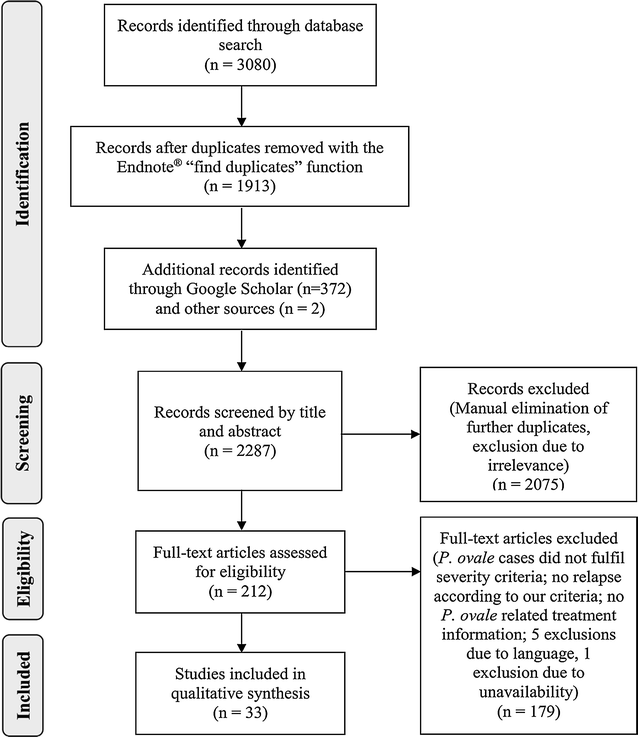A systematic review of the clinical presentation, treatment and relapse characteristics of human Plasmodium ovale malaria
- PMID: 28284211
- PMCID: PMC5346189
- DOI: 10.1186/s12936-017-1759-2
A systematic review of the clinical presentation, treatment and relapse characteristics of human Plasmodium ovale malaria
Abstract
Background: Despite increased efforts to control and ultimately eradicate human malaria, Plasmodium ovale malaria is for the most part outside the focus of research or public health programmes. Importantly, the understanding of P. ovale-nowadays regarded as the two distinct species P. ovale wallikeri and P. ovale curtisi-largely stems from case reports and case series lacking study designs providing high quality evidence. Consecutively, there is a lack of systematic evaluation of the clinical presentation, appropriate treatment and relapse characteristics of P. ovale malaria. The aim of this systematic review is to provide a systematic appraisal of the current evidence for severe manifestations, relapse characteristics and treatment options for human P. ovale malaria.
Methods and results: This systematic review was performed according to the PRISMA guidelines and registered in the international prospective register for systematic reviews (PROSPERO 2016:CRD42016039214). P. ovale mono-infection was a strict inclusion criterion. Of 3454 articles identified by the literature search, 33 articles published between 1922 and 2015 met the inclusion criteria. These articles did not include randomized controlled trials. Five prospective uncontrolled clinical trials were performed on a total of 58 participants. P. ovale was sensitive to all tested drugs within the follow-up periods and on interpretable in vitro assays. Since its first description in 1922, only 18 relapsing cases of P. ovale with a total of 28 relapse events were identified in the scientific literature. There was however no molecular evidence for a causal relationship between dormant liver stages and subsequent relapses. A total of 22 severe cases of P. ovale malaria were published out of which five were fatal. Additionally, two cases of congenital P. ovale malaria were reported.
Conclusions: Current knowledge of P. ovale malaria is based on small trials with minor impact, case reports and clinical observations. This systematic review highlights that P. ovale is capable of causing severe disease, severe congenital malaria and may even lead to death. Evidence for relapses in patients with P. ovale malaria adds up to only a handful of cases. Nearly 100 years after P. ovale's first description by Stephens the evidence for the clinical characteristics, relapse potential and optimal treatments for P. ovale malaria is still scarce.
Keywords: Congenital Plasmodium ovale malaria; Plasmodium ovale; Relapse characteristics; Severe Plasmodium ovale malaria; Treatment evaluation.
Similar articles
-
Systemic pharmacological treatments for chronic plaque psoriasis: a network meta-analysis.Cochrane Database Syst Rev. 2021 Apr 19;4(4):CD011535. doi: 10.1002/14651858.CD011535.pub4. Cochrane Database Syst Rev. 2021. Update in: Cochrane Database Syst Rev. 2022 May 23;5:CD011535. doi: 10.1002/14651858.CD011535.pub5. PMID: 33871055 Free PMC article. Updated.
-
Pyronaridine-artesunate for treating uncomplicated Plasmodium falciparum malaria.Cochrane Database Syst Rev. 2022 Jun 21;6(6):CD006404. doi: 10.1002/14651858.CD006404.pub4. Cochrane Database Syst Rev. 2022. PMID: 35726133 Free PMC article.
-
Home treatment for mental health problems: a systematic review.Health Technol Assess. 2001;5(15):1-139. doi: 10.3310/hta5150. Health Technol Assess. 2001. PMID: 11532236
-
A rapid and systematic review of the clinical effectiveness and cost-effectiveness of topotecan for ovarian cancer.Health Technol Assess. 2001;5(28):1-110. doi: 10.3310/hta5280. Health Technol Assess. 2001. PMID: 11701100
-
Eliciting adverse effects data from participants in clinical trials.Cochrane Database Syst Rev. 2018 Jan 16;1(1):MR000039. doi: 10.1002/14651858.MR000039.pub2. Cochrane Database Syst Rev. 2018. PMID: 29372930 Free PMC article.
Cited by
-
Severe Plasmodium ovale malaria complicated by acute respiratory distress syndrome in a young Caucasian man.Malar J. 2018 Apr 2;17(1):139. doi: 10.1186/s12936-018-2289-2. Malar J. 2018. PMID: 29609605 Free PMC article.
-
Rational malaria chemoprophylaxis - The position of primaquine.Travel Med Infect Dis. 2017 May-Jun;17:3-4. doi: 10.1016/j.tmaid.2017.04.006. Epub 2017 Apr 24. Travel Med Infect Dis. 2017. PMID: 28450186 Free PMC article. No abstract available.
-
Pregnancy and COVID-19: Do not overlook malaria.Int J Gynaecol Obstet. 2021 Jun;153(3):550-551. doi: 10.1002/ijgo.13670. Epub 2021 Mar 29. Int J Gynaecol Obstet. 2021. PMID: 33713432 Free PMC article.
-
A comparison of two PCR protocols for the differentiation of Plasmodium ovale species and implications for clinical management in travellers returning to Germany: a 10-year cross-sectional study.Malar J. 2019 Aug 9;18(1):272. doi: 10.1186/s12936-019-2901-0. Malar J. 2019. PMID: 31399031 Free PMC article.
-
Type material of Plasmodium ovale sensu lato.S Afr J Infect Dis. 2024 Mar 29;39(1):615. doi: 10.4102/sajid.v39i1.615. eCollection 2024. S Afr J Infect Dis. 2024. PMID: 38628423 Free PMC article. No abstract available.
References
-
- WHO. World malaria report 2015. Geneva: World Health Organization; 2015. http://www.who.int/malaria/media/world-malaria-report-2015/en/. Accessed 02 Aug 2016.
-
- Stephens J. A new malaria parasite of man. Ann Trop Med Parasitol. 1922;16:383–386. doi: 10.1080/00034983.1922.11684331. - DOI
-
- Blair DM. Infections with Plasmodium ovale Stephens in Southern Rhodesia. Trans R Soc Trop Med Hyg. 1938;32(229–31):33–36.
-
- Stephens J, Owen DU. Plasmodium ovale. Ann Trop Med Parasitol. 1927;21:293–302. doi: 10.1080/00034983.1927.11684538. - DOI
Publication types
MeSH terms
Substances
LinkOut - more resources
Full Text Sources
Other Literature Sources
Medical
Miscellaneous


